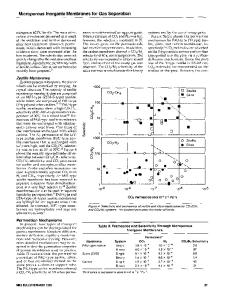Modeling Gas Separation Membranes
- PDF / 258,487 Bytes
- 6 Pages / 612 x 792 pts (letter) Page_size
- 65 Downloads / 415 Views
Modeling Gas Separation Membranes Anthony P. Malanoski2 and Frank van Swol1,2,3 1
Sandia National Laboratories, Advanced Materials Laboratory, 1001 University Blvd, SE, Albuquerque, NM 87106, U.S.A. 2 Chemical and Nuclear Engineering Department, The University of New Mexico 3 Center for Micro-Engineered Materials, The University of New Mexico
ABSTRACT Recent advances in the development and application of self-assembly templating techniques have opened up the possibility of tailoring membranes for specific separation problems. A new self-assembly processing route to generate inorganic membrane films has made it feasible to finely control both the three-dimensional (3D) porosity and the chemical nature of the adsorbing structures. Chemical sites can be added to a porous membrane either after the inorganic scaffolding has been put in place or, alternatively, chemical sites can be co-assembled in a onestep process. To provide guidance to the optimized use of these ‘designer’ membranes we have developed a substantial modeling program that focuses on permeation through porous materials. The key issues that need to be modeled concern 1) the equilibrium adsorption behavior in a variety of 3D porous structures, ranging from straight pore channels to fractal structures, 2) the transport (i.e. diffusion) behavior in these structures. Enriching the problem is the presence of reactive groups that may be present on the surface. An important part of the design of actual membranes is to optimize these reactive sites with respect to their strength as characterized by the equilibrium constant, and the positioning of these sites on the adsorbing surface. What makes the technological problem challenging is that the industrial application requires both high flux and high selectivity. What makes the modeling challenging is the smallness of the length scale (molecular) that characterizes the surface reaction and the confinement in the pores. This precludes the use of traditional continuum engineering methods. However, we must also capture the 3D connectivity of the porous structure which is characterized by a larger than molecular length scale. We will discuss how we have used lattice models and both Monte Carlo and 3D density functional theory methods to tackle these modeling challenges.
INTRODUCTION The success of new self-assembly techniques has indicated the possibility of tailoring membranes for specific gas separation problems. These new approaches have made it feasible to finely control the 3D porosity as well as the chemical nature of the adsorbing structures. This ability to control the resulting structure at such a small scale introduces the possibility of many different structures each with unique properties for gas separation. In order then to design a specific membrane with desired properties a means of guiding the choices to be made on the exact shape of the structure, placement of active sites and the choice of active sites would be beneficial. T2.5.1
One approach that provides such guidance is the use of theory and mo
Data Loading...











